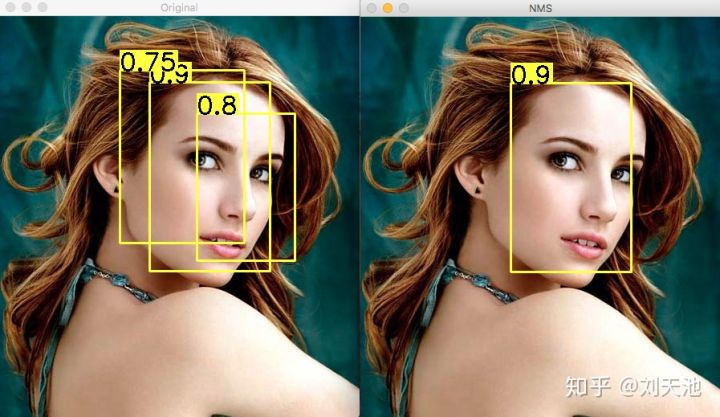非极大值抑制
非极大值抑制,简称为NMS算法,英文为Non-Maximum Suppression。其思想是搜素局部最大值,抑制极大值。NMS算法在不同应用中的具体实现不太一样,但思想是一样的。非极大值抑制,在计算机视觉任务中得到了广泛的应用,例如边缘检测、人脸检测、目标检测(DPM,YOLO,SSD,Faster R-CNN)等。
算法用途
以目标检测为例:目标检测的过程中在同一目标的位置上会产生大量的候选框,这些候选框相互之间可能会有重叠,此时我们需要利用非极大值抑制找到最佳的目标边界框,消除冗余的边界框。
左图是人脸检测的候选框结果,每个边界框有一个置信度得分(confidence score),如果不使用非极大值抑制,就会有多个候选框出现。右图是使用非极大值抑制之后的结果,符合我们人脸检测的预期结果。
nms算法过程
- 根据置信度得分进行排序
- 选择置信度最高的比边界框添加到最终输出列表中,将其从边界框列表中删除
- 计算所有边界框的面积
- 计算置信度最高的边界框与其它候选框的IoU。
- 删除IoU大于阈值的边界框
- 重复上述过程,直至边界框列表为空。
具体代码实现:1
2
3
4
5
6
7
8
9
10
11
12
13
14
15
16
17
18
19
20
21
22
23
24
25
26
27
28
29
30
31
32
33
34
35
36
37
38
39
40
41
42import numpy as np
def py_cpu_nms(dets, thresh):
"""Pure Python NMS baseline."""
x1 = dets[:, 0] #xmin
y1 = dets[:, 1] #ymin
x2 = dets[:, 2] #xmax
y2 = dets[:, 3] #ymax
scores = dets[:, 4] #confidence
areas = (x2 - x1 + 1) * (y2 - y1 + 1) #the size of bbox
order = scores.argsort()[::-1] #sort bounding boxes by decreasing order, returning array([3, 1, 2, 0])
keep = [] # store the final bounding boxes
while order.size > 0:
i = order[0] #the index of the bbox with highest confidence
keep.append(i) #save it to keep
xx1 = np.maximum(x1[i], x1[order[1:]]) #array([ 257., 280., 255.])
yy1 = np.maximum(y1[i], y1[order[1:]]) #array([ 118., 135., 118.])
xx2 = np.minimum(x2[i], x2[order[1:]]) #array([ 360., 360., 358.])
yy2 = np.minimum(y2[i], y2[order[1:]]) #array([ 235., 235., 235.])
w = np.maximum(0.0, xx2 - xx1 + 1) #array([ 104., 81., 104.])
h = np.maximum(0.0, yy2 - yy1 + 1) #array([ 118., 101., 118.])
inter = w * h #array([ 12272., 8181., 12272.])
# Cross Area / (bbox + particular area - Cross Area)
ovr = inter / (areas[i] + areas[order[1:]] - inter)
#reserve all the boundingbox whose ovr less than thresh
inds = np.where(ovr <= thresh)[0]
order = order[inds + 1]
return keep
dets = np.array([
[204, 102, 358, 250, 0.5],
[257, 118, 380, 250, 0.7],
[280, 135, 400, 250, 0.6],
[255, 118, 360, 235, 0.7]])
thresh = 0.3
keep=py_cpu_nms(dets, thresh)
print keep # out:[3]